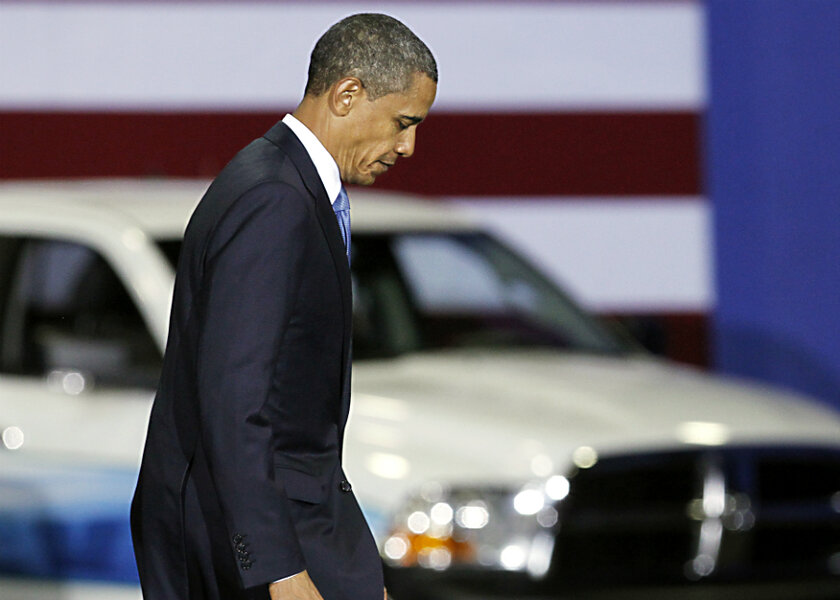EPA aims to preempt Trump with ambitious fuel-economy target
Loading...
| Washington
The Environmental Protection Agency proposed keeping fuel efficiency targets for light-duty vehicles Wednesday in an attempt to preserve one of President Obama’s most aggressive climate change policies.
The decision comes ahead of schedule as part of a mid-term review of a goal to require car manufacturers’ fleets to average 54.5 miles per gallon by 2025. The agency now has 30 days to review public comments.
Announcing the plan early – a preliminary determination was scheduled for 2017 and a final for 2018 – boosts the chances of finalizing the standard by the time Republican President-elect Donald Trump is sworn into office. Mr. Trump’s team has vowed to review the policy.
On the most basic level, the move reflects a political battle as the Obama administration seeks to lock in as much of its policy agenda as possible before a new presidency. But it’s also part of an ongoing debate about the use of federal mandates in the quest to reduce pollution, fight climate change, and enhance the nation’s energy security.
Many economists argue that the other approaches, such as a higher gas tax, would be preferable, by relying on marketplace signals rather than regulations. But the practical reality is that it’s unclear if Trump – a staunch promoter of fossil fuels on the campaign trail – will pursue the goal of cleaner transportation with any form of policy. And proponents of fuel-economy standards say the rules are already reducing America’s oil consumption, and that further big gains are possible.
“It’s clear from the extensive technical record that this program will remain affordable and effective,” EPA Administrator Gina McCarthy said in a statement. "This proposed decision reconfirms our confidence in the auto industry’s capacity to drive innovation and strengthen the American economy while saving drivers money at the pump and safeguarding our health, climate and environment.”
Finishing the standard by Trump’s inauguration could prevent the new administration from scrapping it.
That’s because the midterm policy is not considered a rule, said Nick Conger, an EPA spokesman. That means Republicans couldn’t use a legislative maneuver to overturn regulations, known as the Congressional Review Act, on the fuel economy standard. When the new Congress takes over in January, the GOP could use that tactic to nix any Obama rules issued since May, which includes a number of environmental measures.
“[T]his is not a rule under the Administrative Procedure Act [but rather an adjudication],” Conger said in an email. “This decision is not subject to the Congressional Review Act.”
Congress, however, could still attempt to rewrite the standard through new legislation or undercut it in a spending bill.
"They can always try the legislative route – putting something in a much bigger bill," Jim Manley, a Democratic strategist and former aide to retiring Senate Minority Leader Harry Reid of Nevada, said in an email. Mr. Manley is now director of the communications practice at QGA Public Affairs.
Hiding a rewrite in larger legislation could keep supporters of the Obama standards at bay, saying, "I don't see lots of Dems going to the mat for this."
Motor vehicles are one of the major sources of heat-trapping gases that humans are emitting into the atmosphere, so the standards are a major element of the Obama administration’s effort to ramp up US action to reduce climate change.
Some researchers say the Corporate Average Fuel Economy standards aren't an ideal tool to fight the problem. “Economists have estimated that per gallon of gasoline saved, the old CAFE standards cost 3 to 6 times as much as a gasoline tax,” wrote Lucas Davis, an economist at the University of California, Berkeley, earlier this year.
Proponents of gas taxes (or broader carbon taxes) say the levies can be offset by other tax cuts, and could include rebates to alleviate disproportionate impacts on lower-income households. But any gas-tax hike is still highly controversial, no matter who is president.
The EPA estimates its standard would eliminate 6 billion metric tons of greenhouse gas emissions over the lifetime of vehicles built in model years 2012 through 2025.
The EPA move comes despite protests from automakers that consumers, opting for less efficient vehicles amidst low oil prices, could thwart reaching agency goals. They have pressed the agency to consider weakening the standard.
Wade Newton, a spokesman with the Alliance of Automobile Manufacturers, said his group would work with the Trump White House, Congress and regulators in California – whose standards dictate much of the US auto fleet – “to get things back on track,” calling the EPA move “extraordinary and premature.”
“The evidence is abundantly clear that with low gas prices, consumers are not choosing the cars necessary to comply with increasingly unrealistic standards,” he said in an email. “Wishing this fact away does no one any favors, and getting this wrong has serious implications.”
When the EPA and the National Highway Traffic Safety Administration set the 54.5 m.p.g. target in 2012, it envisioned passenger vehicles would comprise 66 percent of light-vehicle sales and trucks and SUVs would account for the remaining 34 percent by 2025. But a 2015 federal report updated that split to 52 and 48 percent, meaning the vehicle fleet would achieve just 50.8 m.p.g.
But the EPA pointed to progress in the vehicle market as well.
It said that car manufacturers have surpassed fleetwide fuel-economy goals for the program’s first four years, which accounts for model years 2012 through 2015, while auto sales increased for six straight years. It also noted more than 100 cars or light trucks already meet fuel efficiency standards for 2020.
Supporters said securing the standard would lock in production of more fuel-efficient vehicles, noting many manufacturers are rolling out cleaner models and improving the price point and range of electric vehicles. They said those trends would address the transportation sector's effect on climate change, which accounts for more than a quarter of total US greenhouse gas emissions, while also averting health ailments linked to smog and other pollution.
“The Clean Cars Standards are already protecting both Americans’ lungs and their wallets, and they are doing it while driving innovations in car design that are creating jobs and helping automakers earn money,” Environmental Defense Fund President Fred Krupp said in a statement.
Electric vehicle sales, which are projected to increase, also have boomed. Cumulative sales of US plug-in electric vehicles eclipsed 500,000 in September, a sharp spike from the 345 on the road in December 2010, according to the Energy Department. Monthly sales hit a record high of 16,609 in September, and October’s lower figure of 11,351 still represented a 15.6 percent bump relative to October 2015.
The share of electric vehicles on the road is growing, but still small. Plug-in and hybrid vehicles have accounted for 2.82 percent of sales so far this year, according to the Electric Drive Transportation Association.






